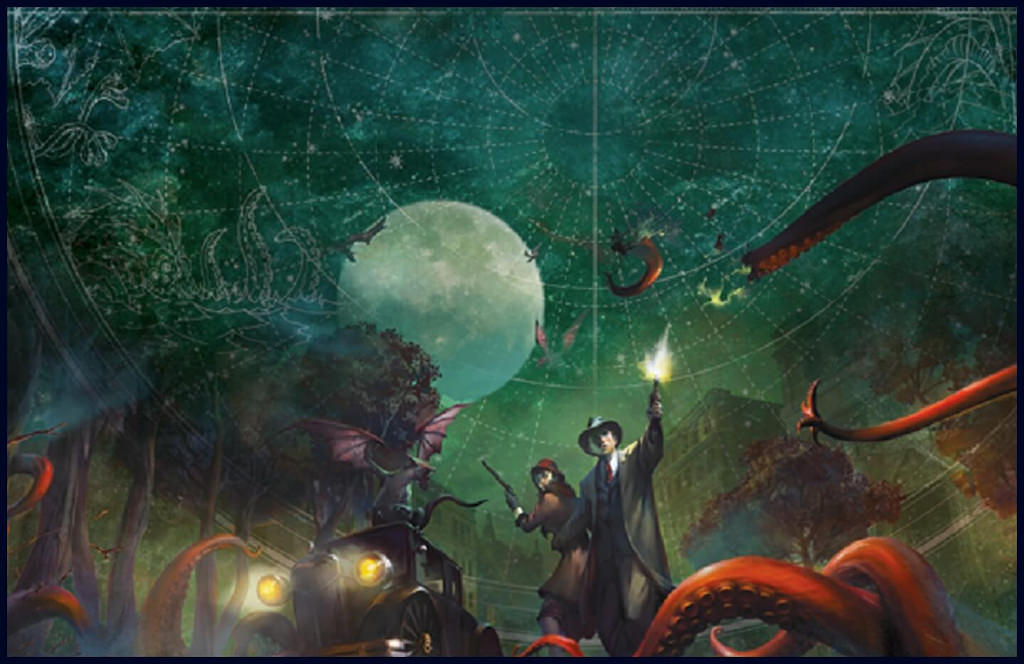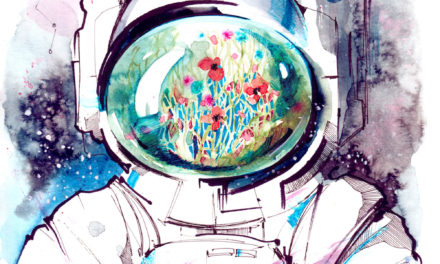What the Racist History Behind Arkham Horror Tells Us About Ourselves
by Hilary Berwick
Issue 2: Game | 1,034 words

©Fantasy Flight Games
First of all, there’s this game. It’s called Arkham Horror.
I tell you this because it’s unlikely you’ve heard of it. Arkham Horror is a niche role-playing game (RPG) based on H.P. Lovecraft’s Cthulhu mythologies.
Lots of people play tabletop RPGs, and most of them play Dungeons and Dragons. (No shame in that game; it was my first tabletop RPG, too—and it’s good, especially if you’ve got a good Dungeon Master.)
The premise of an RPG is in the name: you play roles—you play as other people. And RPGs borrow from basic video game theory to illuminate the stakes. See, video game theory says video games are a big deal because we play in their worlds. Like in movies and novels, video games create gripping worlds we witness. But in games, we participate in those worlds. The stakes are higher. You might recognize this theory implicit in the argument against violent video games (yawn): because games are participatory, when people play ones like Grand Theft Auto, which either demands or allows violence against, say, women sex workers, that cultivates an acceptance of violence against women sex workers. (The limitation to this argument is clear: there has been violence against women sex workers long before Grand Theft Auto.)
RPGs offer similar stakes and, because they’re flexible—somewhere between story-based and sandbox—they let players work through, work with, or explore some of the complexities of the story or the proffered characters. More than that, it makes us responsible for them.
Arkham Horror, as with Lovecraft’s Cthulhu mythologies, takes place around Arkham, Massachusetts in the 1920s. In the game, players work together to fight monsters, acquire tools and skills, and hopefully prevent the Big Bad Monster from coming through. (You can technically still win if the BBM comes through, but it’s a rough slog.)
But here let’s get deeper into the social history in which the game was set. The characters within Arkham Horror heavily reflect the context behind immigration policy in the U.S. Basically, the U.S.’s first immigration policy was “if you’re white and a person, you’re chill.” Seriously. This leaves out so many people—anybody black or brown, any woman—and it deliberately leaves in the people making the decisions, a.k.a. the people who’d just invaded the land.1 That’s our first effort at an immigration policy here in the U.S.: all whites allowed.
Fast forward a hundred years, add in a potato famine and some national and political unrest in eastern Europe, and you end up with a bunch of immigrants from, among other places, Ireland, Germany and Russia. Some of the newcomers were Catholic, some of them were Jewish, and none of them, according to the white people in the U.S. at the time, were white. They were white-ish, or insufficiently white, or white-adjacent, but they definitely weren’t white.
And time keeps chugging along, and then we’re in WWI, fighting countries from which many of these newer immigrants came. We have some Bolshevik revolutions over here, some fascism and its attendant revolts over there, and we also have the creation and rise in the U.S. of the FBI, an institution whose first mission was anti-miscegenation. They were the first national police force enforcing the first federal law in the country: the Mann Act, aka the White Slave Traffic Act of 1910.2
As the U.S. avoided and then entered WWI, the FBI was given a new task: monitor all these non-white folks because you know they’re up to no good. And Congress gave itself a new task too: limiting immigration by nationality, and limiting it specifically to nationalities that were already in the U.S. before these less-than-white folks began arriving, especially the ones that were arriving around the turn of the century. So in 1924, Congress passed an immigration act literally excluding anybody who was Asian and pinning immigration levels to the census of 1890—before all those eastern European, white-adjacent folks entered the scene.
This is the milieu in which Lovecraft is writing, and it’s in this world that Arkham Horror is set. Which means the characters show what was being worked through in the 1920s. And you can see it: you’ve got Lily Chen, one of two East Asian women, whose occupation is Martial Artist; you’ve got Akachi Onyele, the only African person, whose occupation is Shaman; and you’ve got Jim Culver, one of the few Black American characters, whose occupation is Musician, and whose image, on his character card, shows a pensive Black man playing the trombone. They also show this weird frozen-in-amber time capsule of fragile whiteness: the Gangster character has an Irish last name, as does the Ex-Convict (McGlen and O’Toole, respectively), and the Drifter, “Ashcan Pete,” presages some of the poor-white-Okie anxieties that would come out of the Dust Bowl. It’s weird, it’s old-timey, it’s uncomfortable, and we’re playing with it.
Arkham Horror offers two kinds of “play” here: we get to play these characters, and we get to play in a kind of historical moment in which all African people (all one of them) are witch doctors and all Asian people are martial artists (or doctors), while those shifty, poor Catholic white people cannot be trusted. And this matters because these historical moments are being used right now to argue that because this happened in the past, this is actually a normal way of doing things. Contemporary immigration policies are being explicitly predicated on the Immigration Act of 1924 that limited immigration to Anglo-Saxon white nations. Anglo-Saxon wasn’t even really used as a term until this point, because white, legal immigration was considered sufficiently clear until it wasn’t.
So we play in this time period, in the 1920s. And I’m not really arguing we can use the game to fix current immigration problems, although I’d love to. But I am arguing that playing games like this can go one of two ways: it can be an opportunity to ignore racial discomfort (not play any of the non-white cards, not comment on them, presume this sort of thing is In The Past). Alternately, it can be an opportunity to recognize the extent to which history is cyclical, spiral-like, and coming back the fuck around.
1 It’s kind of brilliant if you think about it. These former Englishmen invaded some land, created a government, and then used that government to say they were the only ones allowed to live and be there.
2 And if you want a trip, think about how the Act came only forty-five years after the abolition of slavery in the U.S.—actual slavery. So, Black folks definitely did not have actual rights yet. But the real issue—what we really needed a national police force for—was making sure white women did not get trafficked across state borders by Black men. The Act used a neat little legal trick; the reason we got the FBI, and the reason that Congress could even care about an issue like this, is because of the U.S. Constitution’s Interstate Commerce Clause. White politicians couldn’t say, “we’re really upset because we hate the idea of Black men touching white women,” but they could say, “all white women who go with Black men are prostitutes, which makes them objects of commerce, which means we have the Constitution on our side hunting them down and killing them.” That’s why it’s so weird that Trump just pardoned Jack Johnson, who was one of the early targets of this law and the FBI.

Hilary Berwick
Hilary Berwick is a writer, code monkey, researcher, and meditation practitioner from Brooklyn, Oakland, Texas, and some points in-between. When she’s not meditating, reading books about Pagan rituals, or playing RPGs, she writes queer radical historical fantasy and loves on her bigheaded dog.




